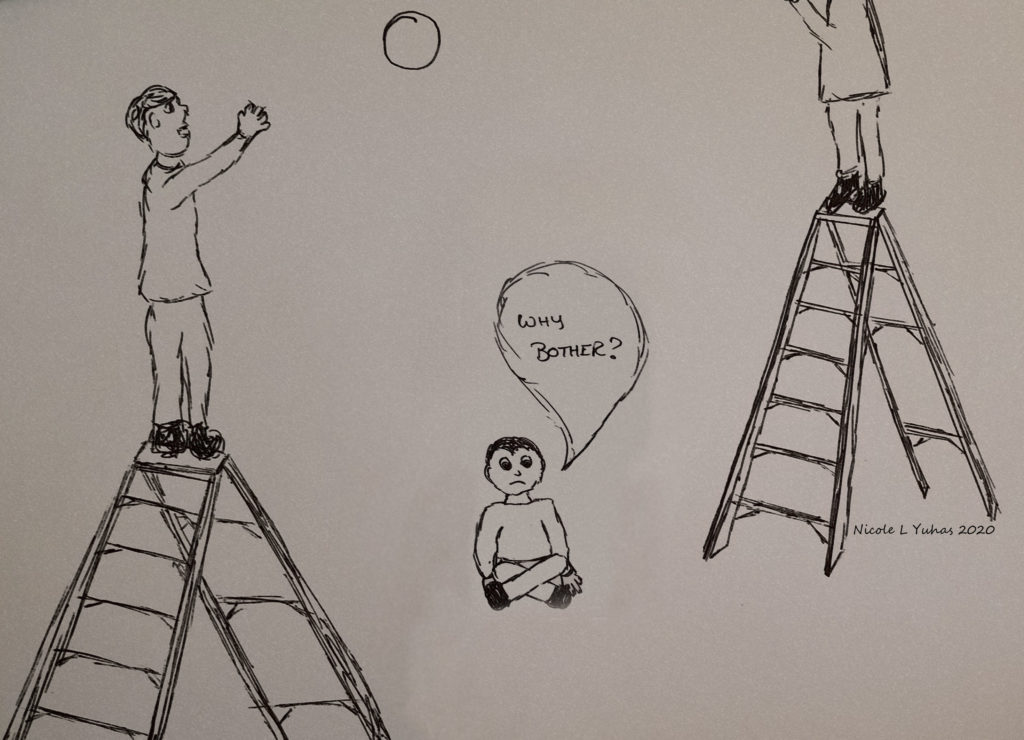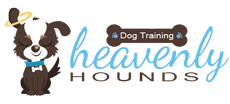Lately, the internet is brimming with ideas for providing enrichment for our dogs. The trend towards finding ways of engaging and enriching our pets and other animals in captivity, like zoo animals, has been one of the best developments in recent history when it comes to animal care, in my opinion. That being said, if we are going to provide these sorts of activities, we need to be certain we are doing so in a way that is fun, challenging, and engaging, and not frustrating and borderline abusive.
So many people can relate to this meme, now stuck at home, without the usual enrichment of daily life outside the home. While this image is humorous, it also points out a real truth: We are the only access our animals have to enriching and engaging activities. If we don’t take them places, they don’t go. If we don’t challenge them, there is no challenge. If we don’t play with them, there is no game. This is why providing enrichment activities is imperative to a healthy pet’s existence.
You probably have seen and heard about various puzzle toys for dogs and maybe even have a few littering the floor of your living room or kitchen right now. I absolutely adore puzzle toys! These are some of the easiest ways to provide some fun and mental exercise into your dog’s daily routine. However, not all games are created equal and we want to make sure we are challenging dogs in a way that is fair. If we simply provide a puzzle, but no means to solve it, we are potentially doing a good deal more harm than good. A dog who has never encountered a puzzle toy might be incredibly frustrated when he or she can smell tasty treats inside but isn’t clear on how to remove them. If they make several attempts and fail each time, frustration may grow either to the point of becoming destructive (I’ll just tear this thing to bits) or to the point that they give up and learn that their human gives them impossible tasks and there is no point to trying to work things out in the future.
And what about the “games” on the internet like this one, referred to as “the carrot game,” in which humans set up a whack-a-mole type scenario with a cardboard box and a carrot.
In this video, you can see the dog stops making attempts to grab the carrot on several occasions, only continuing at the insistence of the dog owner. It is clear to me, and to the dog as well, it seems, that this game really doesn’t have any chance of success. The dog makes an attempt to get the carrot, it goes away. There is no way for the dog to “win” until the owner finally releases the carrot at the end. While I probably wouldn’t call this torture, I don’t think I’d call it fair or fun either. I think it would be a little like playing a game of monkey in the middle (where three people stand in a line and the two people on the end pass a ball back and forth over the person in the middle, and the person in the middle is attempting to snatch the ball out of the air in order to take the place of the person who threw the ball) except that in this version, the people tossing the ball back and forth are on 10 foot ladders and the person in the middle can’t do anything but watch the ball get tossed far above their head, with no chance of intercepting a throw. It might not be torture, per say, but I wouldn’t want to play it.

What about this enrichment activity?
I absolutely adore agility and love getting dogs moving around and over obstacles. There is just one thing I don’t like about this setup. Can you guess what it might be? If you guessed it had to do with the bare hardwood floors, you’d be right. Any enrichment activity we set up for our dog should be as safe as we can make it. Will setting up a course like this on hardwood floors hurt your dog? Maybe not. But, it certainly is a lot less safe than setting this up on a carpet or outside on grass since the risk of your dog slipping and causing joint damage is significantly higher on wood floors. I would ideally make sure anything my dog is jumping over is at an appropriate height for their body size and age (young dogs should not be jumping much at all as their joints are still developing) and the surface on which I’m asking them to jump has both traction and some give to it (like padded carpeting or soft ground).
The question becomes, “how can I be sure that I am providing enrichment in a way that is not frustrating or potentially harmful to my dog?”
- Make the game “winnable.” Teasing a dog is not enrichment, it’s mean! Make sure that there is a clear method that will allow the dog to win. We want there to be a “point” to the game. Remember that the carrot game had no clear way to win. Going for the carrot did nothing most of the time and the owner finally giving it up was completely arbitrary to the dog’s actions. That isn’t fair at all! Make sure the dog wins based on some behavior or action they take. If you can’t identify the behavior or action the dog needs to do, then the activity probably isn’t a good one.
- Make sure your dog has the tools required to solve the puzzle you are providing. If they’ve never used a puzzle toy, start with something on the easier side like a slo bowl, snuffle mat, or likimat, where the food is more easily seen and accessible. Work up to harder toys that require more problem-solving as your dog proves they understand the idea of rooting out or licking out food from interesting objects.
- Help dogs learn the game when you introduce a new toy. One example is the Tricky Treat Ball, one of my personal favorites. The object of the game is to roll the toy around until all the food comes out. If your dog has never played a game like this, where the food is completely tucked inside the toy (unlike a slo bowl where the food is visible), you will want to make the game as easy as possible when you first introduce it. I recommend filling the toy ALL THE WAY so the very first time they sniff it and it moves, food readily comes out. This way, they learn that nudging the toy = a payoff, and that will encourage them to continue to use that tactic. As they have success, you can reduce the amount of food you put in the toy to increase the challenge.
- Ensure enrichment toys are safe. Whenever you are providing a new enrichment activity, you should do so with 100% supervision in case your dog tries to solve the toy in an inappropriate way (example: eating the likimat instead of licking the peanut butter off). Watch how your dog interacts and help them to do it appropriately if they make an unsafe choice. Also inspect the toys between use to make sure there is no damage from wear and tear (cracks in plastic that could harbor bacteria or catch on a dog’s tongue, signs that your dog may have ingested bits of fabric from their snuffle mat which might indicate you shouldn’t use fabric toys in the future, etc). Another thing to check is that toys meant to hold soft food, like Kongs, should have a hole on both ends of the toy to ensure that air can get in from both ends. This prevents a dog from getting their tongue suctioned into their toy when licking out the food.
- Ensure the environment and any equipment you’re having the dog use is safe. Enrichment activities should take place in a safe environment where the dog can’t easily hurt him or herself. Make sure your dog is properly leashed, fenced, or gated so they aren’t at risk of escaping (especially true when you are outside) and make sure that if you are using a leash it is attached in a way that won’t interfere with the task at hand. For example, for some activities I might want to use a harness, not a collar. For other activities, like agility, I don’t want to use a harness because I want my dog to have full range of their legs/shoulders when they are moving. If you are having your dog jump over something, you want to make sure that they won’t get caught on it or hurt their leg if they don’t quite clear the jump. If you are having them jump up onto something, be sure that the platform or surface is stable and unlikely to collapse, shift, or be slick or slippery where they might slide off when attempting to land on it.
Looking for ideas on how to add more enrichment to your dog’s life? Check out the Facebook group Canine Enrichment to see various ideas creative dog owners have come up with. Just be sure to check that all activities you attempt meet the criteria above for a safe and fun experience.
Happy Enriching!
Nicole Lorenzetti Yuhas CPDT-KA
This blog is intended to be informative as well as entertaining. It contains my opinion which may not reflect the opinions of any organization I may be affiliated with. My opinions should not be interpreted as those of my coworkers, family, friends, casual acquaintances, and certainly not the opinion of my cat, although my dog probably agrees with everything I say, if for no other reason, than because I provide the treats and meals (cats are less inclined to agree with anyone but themselves). Information provided here is accurate and true to the best of my knowledge but, as information and opinions change, neither the facts nor the opinions expressed here may be true or accurate at any future date. As I don’t currently own a time machine, I cannot be responsible for things that prove to be untrue, or opinions I change my mind about, should those changes become apparent in the future. It should also be noted that, as I am human, there may be omissions, errors or mistakes in the information provided here. Frankly, even if I were a computer, it is likely there would be errors, as computers, in my experience, can be a royal pain in the butt. This blog may contain affiliate links which you are under no obligation to click. If you click them, they will hopefully take you the place I intended. But they may not. As I’ve said, computers can be a pain. If you find yourself somewhere you don’t think I intended, click your ruby slippers three times together and say, “there is no place like home.” If you do that, and click the “back” button, you should be safely returned. Computers can, at times, have a mind of their own. Any training suggestions or opinions expressed here should be taken as information only and should not be seen as advice particular to you or your dog’s unique situation. Please consult with a training professional before taking any action.
